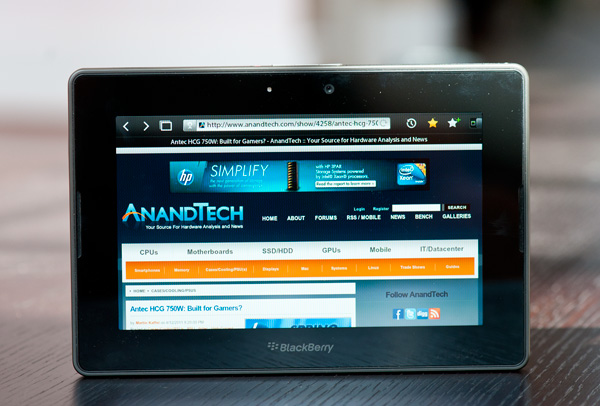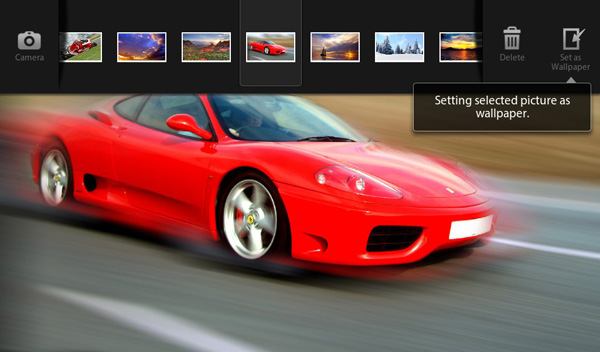The BlackBerry PlayBook Review
by Anand Lal Shimpi on April 13, 2011 9:00 PM EST- Posted in
- Tablets
- Smartphones
- RIM
- BlackBerry
- PlayBook
- Mobile
A Functional Bezel
The PlayBook supports all of the basic gestures we've come to expect from mobile devices with a capacitive touchscreen. There's flick to scroll, pinch to zoom and pretty much anything else you'll encounter on an iOS or Android based device. What RIM adds with the PlayBook are gestures that originate in the bezel of the device.
Any gestures within the 7-inch LCD area control the currently running app. Any gestures that originate in the bezel around the screen however are a different story. The first is the unlock gesture. Swipe up/down, left/right or the opposite direction when the PlayBook is asleep and you'll wake it up. There's no support for passcode locking and no physical unlock switch (although the power button will work in a pinch) - all you need to do is take one finger starting from a point on the bezel and slide it up or across. I've noticed that you have to be pretty committed when unlocking, anything less than swiping up/across 50% of the screen won't register as an unlock swipe. I suspect this is to ensure that no accidental swipes unlock the PlayBook when in your pocket/purse/othercavity.
Once unlocked, a swipe up from the bottom bezel will do one of two things depending on the state of the PlayBook. If you're at the home screen, swiping up from the bottom bezel brings up the entire app launcher instead of just the top row of apps. If you're in an app, a swipe up will reduce the active app to a thumbnail, expose the webOS-style task switcher and display a part of the home screen.
Swipe from the top bezel downward within an app and you'll either reveal a contextual menu for the app or you'll pull down the system settings page.
What about the left/right bezel? That's what you use to quickly switch between apps of course. Imagine an infinitely wide desktop where your viewport is big enough to hold on full screen app. To get to any active (even paused) app to the left or right of what you're currently looking at, just swipe left (or right) beginning in the bezel and you'll swap apps. If you only have one app running the OS will try to animate your current app sliding away but it'll bounce back, as if to tell you that you've reached the end of the horizontal list.
The bezel gestures don't stop there. Swipe up from the lower left corner and you'll bring up the PlayBook's virtual keyboard, in any app. This is a particularly puzzling gesture because you can bring up the keyboard even in apps that can't use a keyboard. And no, the keyboard shortcuts from the BlackBerry OS don't work on the PlayBook.
The lower right corner doesn't do anything but swipe from either of the upper two corners and you activate what RIM calls the peek gesture. The peek gesture gives you a quick look at the top status bar - including any notifications, date/time and battery status.
The bezel based gestures work well on the PlayBook although I'm not sure how long term of a solution this will be. Users tend to prefer thinner bezels - a direction I ultimately see all tablets going.












77 Comments
View All Comments
legoman666 - Wednesday, April 13, 2011 - link
No email client? Really? Is that a joke?Ethaniel - Wednesday, April 13, 2011 - link
For now it seems, but that's clearly a sample unit. All I keep reading is "needs tuning" and "needs optimization", ergo, it's not ready, and they're going to launch it anyway. Those updates will have to be lightning-fast. I don't want to pay 500 dollars to be a beta tester...SimKill - Wednesday, April 13, 2011 - link
I'm actually surprised. This is because my cousin in India said that his friend in Dubai already bought it and has it for quite some time. Do you think there might be a reason why they are purposely delaying the American release?melgross - Thursday, April 14, 2011 - link
Probably, someone is lying about it, or they've gotten some illegally obtainedRe
Reduction model much as what happened the Apple's iPhone 4.
It's first being released in N. america, according to RIM.
vol7ron - Friday, April 15, 2011 - link
Why does everyone want to price around Apple? The more I look at these devices, the more I'm likely to get the color-nook and put Droid on it. Surely the hardware would be lacking, but the functionality would still be ballpark.16GB for $500 is ridiculous. These base models need to be in the $250-300 range.
michael2k - Friday, April 15, 2011 - link
Um, the raw materials for the iPad is about $260, meaning you can't expect to buy a 16gb tablet from any manufacturer, especially one with less buying power than Apple, for much less than $400 or so.From the iPad 2:
Display is $127
Flash is about $66 for 32gb, $35 for 16gb
Case & Battery is about $60
Mobo+Camera is about $60
So for any 10" tablet the cost if they gave it away for free would be $282 or so. Your nook "cheaps out" by having a 7" screen, only 8gb storage, a slower CPU, no cameras, and a much smaller battery. It only gets 8 hours with wifi off, the iPad 2 gets 11 hours with wifi on!
In other words you're only paying $180 worth of HW in the Nook, while the iPad gets you two 1GHz cores vs a 800MHz core, 11h of battery vs less than 8 hours, 10" and 1024x768 vs 7"@1024x600, 16gb vs 8gb, and of course, no guarantee of OS updates. You're complaint is ridiculous, actually, since almost no other manufacturer has been able to beat Apple on price yet except the Acer Iconia.
quiksilvr - Friday, April 15, 2011 - link
As much as I despise Apple, I have to agree to an extent. Yes that price is quite hefty, but if Apple didn't have it's cult following, it would have easily been on sale for $399. But thanks to idiot consumers, they can bump it up a Benjamin.michael2k - Friday, April 15, 2011 - link
And no one else can order in vast enough quantities to hit the $399 price.mcnabney - Friday, April 15, 2011 - link
I am starting to doubt the iSupply numbers you quoted.They price the very nice 9.7" IPS screen that Apple uses at $129 while the clearly inferior non-IPS screen the XOOM uses at $140. Their memory prices are also highly suspect, clinging to $2/GB for what are still really small drives compared where higher performing SSDs already are. I would guess that NAND prices for tablets are under $1/GB wholesale and in quantity.
michael2k - Friday, April 15, 2011 - link
Apple orders literally 2m 9.7" IPS screens a month, probably 40m this year alone. That gives them bulk purchasing power no one else has except the manufacturer of said screens.Motorola has to pay market prices, while Apple can literally buy an entire factory's output. http://www.isuppli.com/Display-Materials-and-Syste...
It doesn't help that the Japanese earthquake halted LCD production at major plants, either!
As for SSD chips, Apple is paying a premium to get density. The low end iPad has only a single SSD 16GB chip. The mid range iPad has one or two, and the high end has two 32GB chips. As soon as prices are good or capacity is good, I'm sure Apple will use a single 32gb chip on the low end, two 32gb chips for the middle, and 2 64gb chips on the high end.